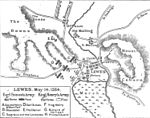Lewes Victoria Hospital
1847 establishments in EnglandHospital buildings completed in 1909Hospitals established in 1847Hospitals in East SussexLewes ... and 3 more
NHS hospitals in EnglandSouth East England building and structure stubsUnited Kingdom hospital stubs

Lewes Victoria Hospital is a health facility at Nevill Road in Lewes, East Sussex, England. It is managed by the Brighton and Sussex University Hospitals NHS Trust.
Excerpt from the Wikipedia article Lewes Victoria Hospital (License: CC BY-SA 3.0, Authors, Images).Lewes Victoria Hospital
Hawkenbury Way,
Geographical coordinates (GPS) Address Nearby Places Show on map
Geographical coordinates (GPS)
| Latitude | Longitude |
|---|---|
| N 50.875 ° | E -0.0054 ° |
Address
Lewes Victoria
Hawkenbury Way
BN7 1LT , Wallands Park
England, United Kingdom
Open on Google Maps










